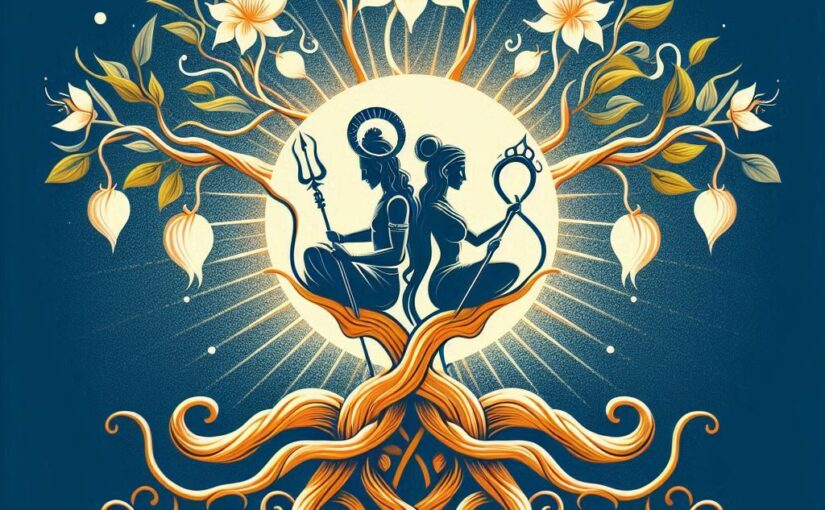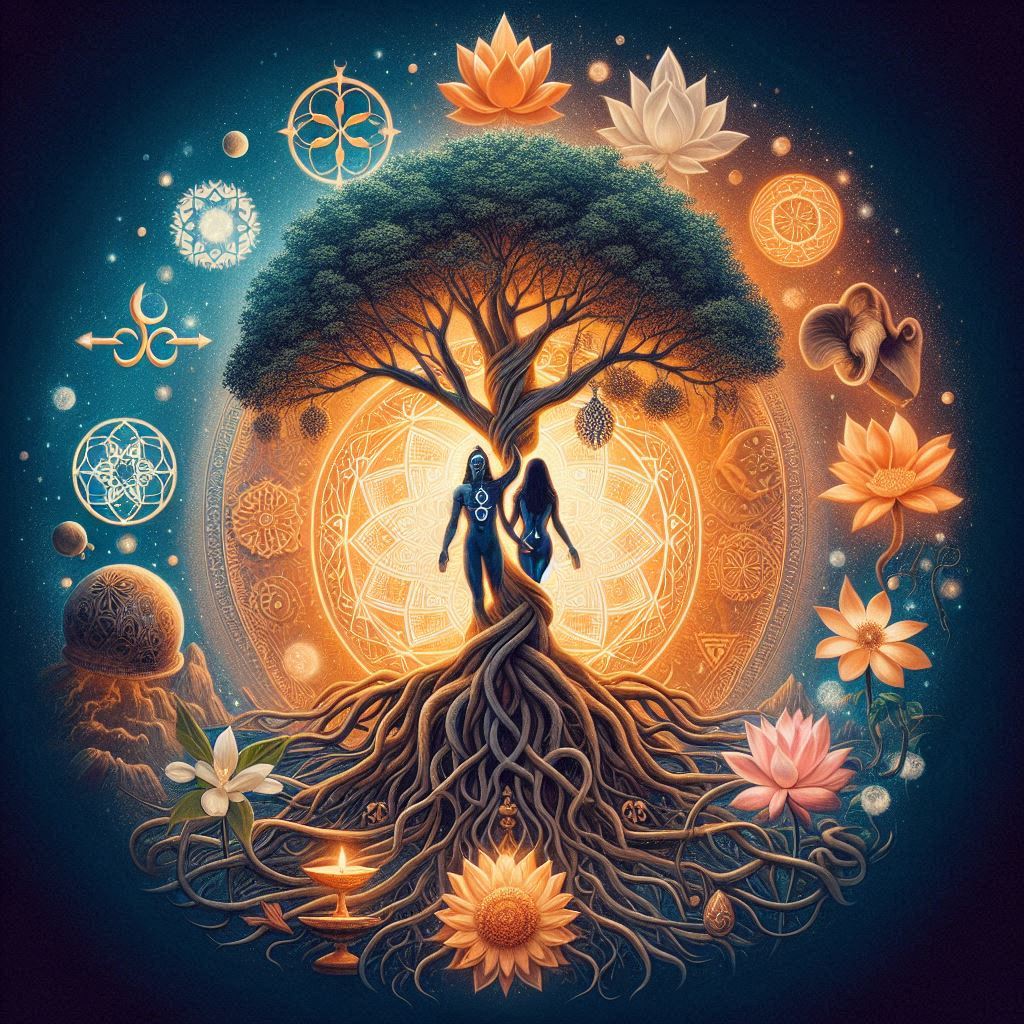When I was just 12 years old, I watched a TV serial on Doordarshan where, before his marriage, Lord Ram was asked about the place of women in his life. With great love and respect, he said, ‘A woman is someone without whom a man is incomplete. Only through the union of man and woman does a man become whole, which is why a woman is also called Ardhangini (half of the body).’
Then, Mata Sita was asked about the role of a husband in life. She said, ‘A woman is like a creeper, and a man is like a tree. Just as a creeper cannot rise without a tree, similarly, life cannot be complete without both man and woman.’
In another story, a disciple once asked a sage mother about the difference between a husband and a father. She explained, ‘A father is the giver of life to a woman, but a husband completes her and provides her with ultimate bliss (the supreme joy of union).’
As I grew up, I heard and saw countless stories about marriage, women, and relationships in society, but none seemed as pure as the ancient ideals of Sita and Ram.
I completed my studies in science, pursued a job, got married, and had children. In essence, I progressed through different stages of life. Now, I also run a gurukul, where I teach students. While teaching biology, I came across some profound truths.
During my student years, I studied only to score marks, to pass exams, and to secure a job. Since life’s sole goal was marks and employment, I never reached the deeper meanings of subjects. This is one of the great failings of the 21st century—everything has turned into a business, whether it’s education, teachers, love, marriage, or even intimacy. Everything is being sold in the marketplace, including human bodies. Hundreds of girls, once pure like the sacred river Ganga, have been reduced to mere commodities.
What a paradox it is that a woman, without whom a man is incomplete, is separated and placed in a market where her soul is shattered. This exploitation has been happening for centuries, and yet, we have grown accustomed to it, accepting societal vices without protest. If someone were to resist, the authorities might suppress them because today’s age is the age of Vaishya (merchants), not Veshya (prostitutes). Notice I said Vaishya, not Veshya. In this age, every human being, regardless of caste (Brahmin, Kshatriya, Vaishya, or Shudra), religion, or nationality, seeks to engage in trade.
Trade, in itself, is not a wrongdoing, but when one sells their conscience, it is unacceptable. How can a man be satisfied merely by touching a woman’s body when the body is only a gateway to the soul? Intimacy is a fundamental law of nature for all living beings—even our deities engaged in it. But what did they achieve that we failed to? They touched the soul through the body, experiencing the infinite sweetness of union through love and surrender, whereas humans remained confined only to physicality, lost in the marketplace and transactions, never reaching deeper spirituality.
The day you realize which things should be valued and which are priceless, you will step away from this marketplace. This transformation is only possible when spiritual wisdom awakens in a person—when they follow the ideals of Lord Ram. A man who considers his wife as his Ardhangini will never touch another, and the more men understand this truth, the less commercialized exploitation will occur. Instead of just worshiping an idol of a woman, the true reverence lies in respecting real women—honoring their souls and embracing them in love and unity.
Men and women are not separate. All followers of Sanatan Dharma worship Shivalinga, yet few realize its symbolism. Shivalinga represents the union of masculine and feminine energies—Shiva’s linga and Parvati’s yoni. It signifies that despite having different physical forms, man and woman are one.”
We can understand this concept even through modern science textbooks. Science explains that there are three types of flowers. The first type has both male and female reproductive organs within the same flower, enabling self-pollination. The second type has separate male and female flowers on the same plant, allowing cross-pollination between flowers, though the plant itself remains the same. The third type consists of plants where only one type of flower exists—for instance, female flowers on one tree and male flowers on another. In these cases, cross-pollination occurs when pollen is transferred from the male flower to the female flower via wind, water, insects, or birds, ultimately leading to the formation of fruit.
In the beginning, male and female reproductive parts existed in the same flower (just like in a single body). Over time, evolution took place—male and female flowers started appearing on separate trees, but their union was still necessary for fruit formation. As evolution continued, this pattern extended from plants to animals. Males and females began to be born in separate bodies, yet procreation required their union (reproduction). Despite their individual existence, they remained incomplete without one another—Ardhangini (each other’s missing half)—and could only complete life through unity. This knowledge, shared by Lord Ram and Mata Sita centuries ago, is reaffirmed by the symbolism of Shivalinga, as male and female unite through their reproductive organs.
This also validates my writings on Sanatan Dharma and early science, proving how advanced our ancestors were.
The books remain the same, but what I couldn’t learn as a student, I now grasp as a teacher. Science provides clarity on how creation was structured, how the sun, planets, and stars formed, and how life began on Earth. It explains how life evolved from single-celled organisms in the depths of the ocean to multi-cellular beings and eventually how sexual reproduction emerged.
But the tragedy of the modern era is that society witnesses the commercialization of women’s bodies yet turns a blind eye. Everywhere—from the internet to obscene magazines—women are portrayed in a vulgar manner, and men remain consumed by these images.
Obscenity prevails in society, yet in schools, teachers fail to properly educate students about reproduction. No one really wants to learn in classrooms; instead, the primary goal is securing marks and landing a job—as if life has no purpose beyond that.
When I teach students about sexuality, girls exchange glances with their peers, lowering their heads and smiling discreetly, while boys smirk at each other—because they have only encountered the obscene side of sexuality, never the scientific side.
What irony! The hands of young children, which should hold toys, now hold smartphones where they consume everything—from explicit images of women to obscene videos.
Even fourth-grade children—and young girls—have such videos stored on their phones. The pandemic and online education further ensured that every child had access to mobile devices, making everything available in the marketplace for them.
Yet, as an unconventional guru, I silence their giggles and explain: I am not merely teaching sexuality, but its evolution—how Earth (land animals), air (birds), and water (fish) all rely on sexual reproduction to bring forth offspring. But have you only heard of sexuality in its limited sense? Step beyond that understanding and truly grasp the concept.
I emphasize that sexuality is not something to hide, yet parents and teachers rarely discuss it openly. This is because sexuality is powerful—it has the ability to consume both men and women, and no one knows when someone might lose control and act upon impulse. That fear is why people shy away from conversations about it.”
During student life, when hormones start being secreted, it is natural for boys to feel attracted to girls and girls to boys. This will happen, and no one can stop it. If not one person, then another; if not them, then someone else—eventually, someone will seem appealing. However, at this stage, since only hormones are at play, the brain has not yet fully developed. Today, someone may seem attractive, but in two to four months or years, someone else may take their place. No one openly discusses this, but as adults, it is our responsibility to guide them.
Parents and teachers often try to restrict children at this age. However, this article serves as a lesson for all parents and teachers—children will inevitably like someone, and no one can stop this. Their DNA is programmed even before birth to determine how many months they will stay in the womb, when they will be born, when they will start speaking, when they will begin walking, and when they will reach adulthood. They are not doing this by choice; they are simply following their biological programming (DNA coding). They must be told to acknowledge what they feel—because their brains are still developing, and in time, their preferences may change.
It takes 30 to 35 years for the brain to fully mature, but no one can wait that long. At the very least, the law requires them to reach the legal age for marriage; otherwise, police action could be taken. They must also understand that a wife is an Ardhangini, a significant presence in their life. They should acknowledge their feelings but also allow time to guide them—time will reveal who will become their true partner and whose paths will diverge.
When such discussions take place, children’s perspectives change. I have observed a shift in the mentality of my students—girls have become more courageous, engaging in conversations with confidence rather than avoiding eye contact. Even boys have undergone a change in mindset. You can bring about this change too, but first, you must control your own desires. Speaking or educating about sexuality is not easy. But think—how do medical professionals and students assist in childbirth? Because they see it as their duty. Then, when they return to their partners at night, they experience intimacy in its proper form.
You must understand sexuality, study it, and then teach others. This transformation cannot be achieved by a single person; it will take generations of practice to finally eliminate the commercialization of human bodies. Awareness must be spread so that no woman is degraded, and genuine respect is given to both women and men. Only then will relationships and unions be meaningful.


